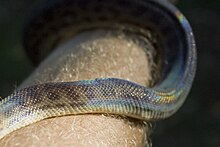This is an old revision of this page, as edited by 96.236.213.217 (talk) at 11:55, 25 November 2011 (Added synonymy, with citations.). The present address (URL) is a permanent link to this revision, which may differ significantly from the current revision.
Revision as of 11:55, 25 November 2011 by 96.236.213.217 (talk) (Added synonymy, with citations.)(diff) ← Previous revision | Latest revision (diff) | Newer revision → (diff)| This article's tone or style may not reflect the encyclopedic tone used on Misplaced Pages. See Misplaced Pages's guide to writing better articles for suggestions. (September 2010) (Learn how and when to remove this message) |
| Antaresia childreni | |
|---|---|

| |
| Children's python | |
| Conservation status | |
| Not evaluated (IUCN 3.1) | |
| Scientific classification | |
| Kingdom: | Animalia |
| Phylum: | Chordata |
| Subphylum: | Vertebrata |
| Class: | Reptilia |
| Order: | Squamata |
| Suborder: | Serpentes |
| Family: | Pythonidae |
| Genus: | Antaresia |
| Species: | A. childreni |
| Binomial name | |
| Antaresia childreni (Gray, 1842) | |
| Synonyms | |
Children's python (Antaresia childreni) is a nonvenomous python species found in Australia.
Etymology
Both the common name, Children's python, and the specific name or epithet, childreni, are in honor of English scientist John George Children.
Description


Adults grow to an average length of about 1m (~3ft), with a maximum of 1.5m (~5ft). The crown scales are enlarged while those on the body are small and smooth, with a rainbow sheen that can be seen when exposed to direct sunlight.
Geographic range
Found in Australia in the extreme north of Western Australia, the northern third of Northern Territory, and northeastern Queensland. Also on the islands of the Torres Strait. The type locality given is "?" Listed as "N.W. Australia" in the catalogue of the British Museum of Natural History and as unknown in Stimson (1969).
It occurs specifically in the region spanning along the coast between the Kimberleys in Western Australia to Mount Isa in northwestern Queensland.
Diet
The diet consists of reptiles, birds and small mammals, particularly microbats which they catch by dangling from stalactites in caves, which they commonly inhabit, and snatch them out of the air as they fly past.
Reproduction
Oviparous, with up to 25 eggs per clutch. Females brood their eggs through a seven week incubation period by coiling around them and occasionally shivering to keep them warm, which also affords the eggs some protection from predators. Juveniles are heavily blotched, but gradually become reddish brown or brown as they mature.
Captivity
Often kept as a pet due to its good nature and less demanding requirements. The lifespan of captive specimens has been known to exceed 30 years. Juveniles are fed on pinky mice (baby, hairless mice), while larger individuals can be fed on adult mice or small rats. Feeding should occur roughly once a fortnight.
Taxonomy
Anterisia childreni is one of four species of Antaresia, a genus of the family Pythonidae named after the star Antares. John Edward Gray published the original description of the species in 1842, naming it Liasis childreni. The specific epithet, conserved in the current name, is in honour of Gray's mentor, John George Children, a curator of the zoological collection at the British Museum around that time. No subspecies are currently recognized. Some species of the genus Altaresia were formerly assigned to the genus Morelia.
See also
- List of pythonid species and subspecies
- Pythonidae, valid scientific names
- Pythonidae by taxonomic synonyms
References
- Boulenger, G.A. 1893. Catalogue of the Snakes in the British Museum (Natural History). Volume I., Containing the Families Typhlopidæ, Glauconidæ, Boidæ, Ilysiidæ, Uropeltidæ, Xenopeltidæ, and Colubridæ Aglyphæ, Part. Trustees of the British Museum (Natural History). London. p. 77.
- The Reptile Database. www.reptile-database.org.
- Mehrtens JM. 1987. Living Snakes of the World in Color. New York: Sterling Publishers. 480 pp. ISBN 0-8069-6460-X.
- ^ McDiarmid RW, Campbell JA, Touré T. 1999. Snake Species of the World: A Taxonomic and Geographic Reference, vol. 1. Herpetologists' League. 511 pp. ISBN 1-893777-00-6 (series). ISBN 1-893777-01-4 (volume).
- "Antaresia childreni". Integrated Taxonomic Information System. Retrieved 19 September 2007.
- "IUCN Red List of Threatened Species". Retrieved 2008-09-06.
External links

- Antaresia childreni at the Reptarium.cz Reptile Database. Accessed 19 September 2007.
- Children's Python (Antaresia childreni) at Antaresia.com. Accessed 4 May 2008.
- Antaresia pythons - breeding cycle at Antaresia.com. Accessed 4 May 2008.
- Children's Python Care Sheet at tinypythons.com. Accessed 19 September 2007.
- Children's Python fact sheet at Burke's Backyard. Accessed 19 September 2007.
- Reptile keeper's licence at NSW National Parks and Wildlife Service. Accessed 19 September 2007.
- Children's Python care sheet Accessed 31 July 2011.